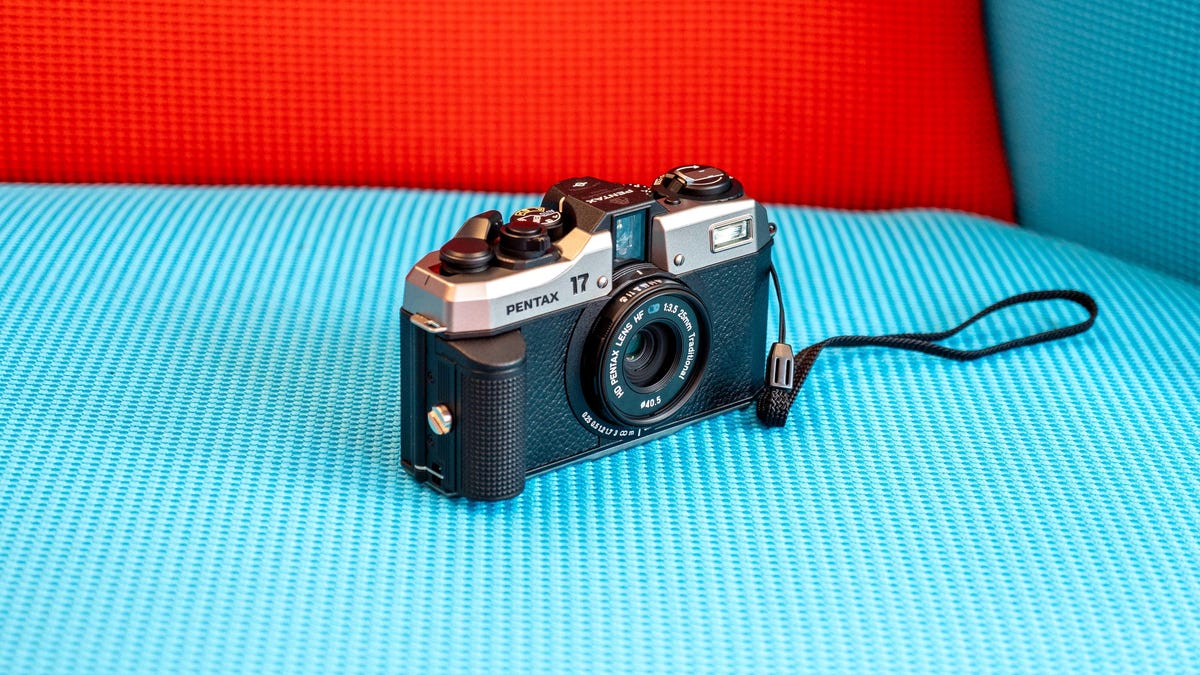
Like cassettes and vinyl records (and even dumb phones), film photography is having a resurgence. However, getting your hands on a new turntable or cassette deck is easier than a new 35mm film camera unless you want a toy camera or a $5,600 Leica Rangefinder. The new Pentax 17 I recently shot with fills that need with a great blend of manual operation and point-and-shoot performance in a compact design.
While it’s easy enough to find a used camera, the idea for the $500 Pentax 17 is to give those new to shooting film an option without worrying about the condition of the camera or lens. The camera’s features are a step above the $400 Lomo LC-Wide and well beyond the bare-bones $45 Kodak Ektar H35. It’s a half-frame 35mm camera, so you get two 24-by-17mm pictures for each 35mm frame. Film prices are pretty high, as is developing, so getting 72 shots from a roll of 36 certainly helps. Plus, the vertical frames are more in step with phone photography.
The Pentax 17 is a half-frame camera, so you get two shots for every 35mm film frame.
The Pentax 17 uses an Albada bright-frame viewfinder with composition frames for normal and close-distance shots. It has an f3.5 37mm lens (35mm equivalent) based on optics from the Pentax Espio Mini, which is redesigned for the half-frame format. In fact, several of the design features are borrowed from past Pentax cameras, including the manual film advance lever and shutter release, the manual film rewind assembly and the built-in flash.
The camera uses a zone-focus system from 0.8-foot to infinity.
Instead of full manual or autofocus, the camera uses a zone-focus system with six zones: 0.8, 1.7, 4, 5.6, 10 feet and infinity (0.25, 0.5, 1.2, 1.7, 3 meters and infinity). Just twist the dial around the lens to the pictograph representing what you’re shooting, and you’re done. If you can’t remember the subject distance for each zone, they’re marked below the lens, and you can see the pictograph through the viewfinder to double-check the setting.
Focal zone distances are listed below the lens.
Shutter speeds range from 1/350th to 4 seconds. There’s also a Bulb setting and an optional cable switch sold separately so you don’t inadvertently shake the camera while holding the shutter open. There are two sets of shooting modes — with flash and without — and in between them on the dial is a Full Auto mode that uses the built-in metering to trigger the flash.
In addition to Full Auto, there’s a standard Program, Slow-speed Shutter and Bokeh (maximum aperture priority) without flash. With the flash, there’s a Program (daylight sync) and a Slow-speed Program. There’s also a ±2EV exposure compensation dial on the opposite side of the viewfinder from the mode dial.
The mode dial is split into modes with flash and without, with a Full Auto mode in between.
The manual controls — from loading the film to advancing frames — give it the tactility that’s missing from simple point-and-shoot film cameras like the Kodak I mentioned earlier. And it’s definitely missing from the phone photography experience. The body is relatively lightweight at 10.2 ounces (290 grams), and although it’s not slim (partly because of the right-hand grip that holds the single CR2 lithium battery), keeping it in a backpack or jacket pocket isn’t an issue. The Pentax 17 is mostly plastic, but the top and bottom are magnesium alloy, which gives it a nicer look and feel. I wish metal were used for the dials, film advance lever and shutter release, but balancing costs (and weight, for that matter) can’t be easy.
Pentax included a note holder on the back to hold the tab from the end of the film package.
The camera supports nine ISO speeds: 50, 100, 125, 160, 200, 400, 800, 1600 and 3200. A manual winder on top pops open the back, letting you drop a roll in quickly. With about four or five cranks of the advance lever, you’re ready to start shooting. A note holder on the back cover gives you a place to tear off the tab from the film package, so you know what film you’re shooting.
I haven’t shot film in about a decade, other than with an instant camera. I’m excited to see the results from the roll I shot with the Pentax 17. (Well, except for the first few shots where I forgot to take the lens cap off; there is a warning light to the right of the viewfinder to help prevent that, too.) Like the imperfections of records and cassettes, film photos seem more real than digital photos. Holding a print that I shot without being able to magically remove the flaws is something special. And while the camera, film and processing aren’t cheap, shooting film can change how you think about photography and capturing your friends, family and experiences.